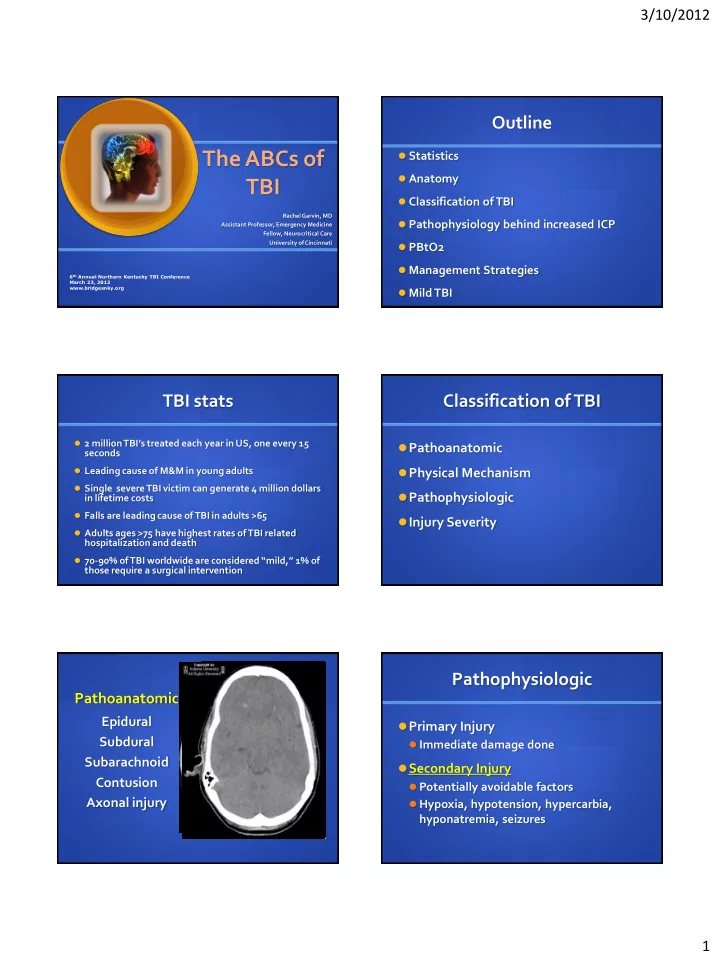

3/10/2012 Outline The ABCs of Statistics Anatomy TBI Classification of TBI Rachel Garvin, MD Pathophysiology behind increased ICP Assistant Professor, Emergency Medicine Fellow, Neurocritical Care University of Cincinnati PBtO2 Management Strategies 6 th Annual Northern Kentucky TBI Conference March 23, 2012 www.bridgesnky.org Mild TBI TBI stats Classification of TBI 2 million TBI’s treated each year in US, one every 15 Pathoanatomic seconds Leading cause of M&M in young adults Physical Mechanism Single severe TBI victim can generate 4 million dollars Pathophysiologic in lifetime costs Falls are leading cause of TBI in adults >65 Injury Severity Adults ages >75 have highest rates of TBI related hospitalization and death 70- 90% of TBI worldwide are considered “mild,” 1% of those require a surgical intervention Pathophysiologic Pathoanatomic Epidural Primary Injury Subdural Immediate damage done Subarachnoid Secondary Injury Contusion Potentially avoidable factors Axonal injury Hypoxia, hypotension, hypercarbia, hyponatremia, seizures 1
3/10/2012 Injury Severity Predicting Outcomes GCS Study using data from CRASH trial looked at predicting outcomes (death at 14 days 13-15 Mild TBI and death/disability at 6 months) 9-12 Moderate TBI Best predictors: age (>40), low GCS, <8 Severe TBI obliteration of basal cisterns/third ventricle, pupillary response, other extracranial injuries Rotterdam CT scoring Imaging Basal Cisterns: open, compressed, absent Noncon Head CT Midline Shift: < or > 5mm MRI Epidural Mass Lesion CTA IVH or Traumatic SAH Other trauma imaging ICP Cerebral Perfusion Pressure (CPP) Monroe-Kellie Hypothesis: Blood, brain, CPP = MAP-ICP CSF Normal CPP >50mmHg Normal ICP 5-15mmHg (3-7mmHg young CBF: children) Directly proportional to CPP and vessel radius In TBI, the balance gets disrupted Inversely proportional to blood viscosity and vessel length 2
3/10/2012 Causes of Increased ICP Monitoring in TBI Intracranial Extracranial ICP Hematomas/Contusio Hypoxia ns Hypercarbia Brain tissue oxygen Ischemia Hyper/Hypotension Hydrocephalus Head rotation Microdialysis Increased CBF Fever Seizure Jugular venous saturation Increased intraabdominal Cerebral blood flow pressure How do we treat low PBtO2? What about brain tissue oxygen? Secondary brain injury not always associated with increased ICP Increase oxygenation Study by Spiotta et al looked at conventional ICP/CPP management vs PbtO2-based therapy Increase MAP 70 pts with severe TBI managed with Licox to keep PbtO2 Change PCO2 > 20mmHg as well as ICP/CPP Compared with 53 historical controls with goal of ICP <20 and CPP >60 Lower mortality and more favorable short term outcomes Early Management of TBI ABC’s Airway ABC’s Avoiding hypoxia RSI Imaging Post-intubation sedation Emergent treatment Breathing Normocarbia Circulation Avoiding hypotension 3
3/10/2012 Treating ICP Mannitol vs Hypertonic Saline Mannitol HTS Keeping things “normal” Rheologic effects Osmotic effect Osmotic effects Can be used in Sedation hypovolemic pts Crosses BBB Can cause Contraindicated in Positioning hyperchloremic hypovolemic pts acidosis, Mannitol/Hypertonic saline decreased platelet aggregation Emergent Treatment Hyperventilation Decreased PaCO2 alkalinizing CSF Hyperventilation cerebral vasoconstriction Decompressive Decreased CBV decreased ICP, BUT……… Hemicraniectomy Effects last around 6 hours until CSF pH equilibrates Then there is re-dilation of cerebral arteries rebound ICP Decompressive Hemicraniectomy Outcomes Most often a rescue procedure Difficult to make early predictions on outcome Initial GCS Data equivocal on whether Pupils/Motor Score outcomes improved Other injuries MR spectroscopy Specialty care in neuro- ICU’s improve outcomes 4
3/10/2012 Mild TBI Mild TBI Study by Sterr et al looked at long term effects of Study by Bazarian et al looked at mild TBI in the ED MTBI Used the NHAMCS for isolated mild TBI 29% of MTBI patients had symptoms of PCS at least 12 months post injury (as compared with Less than ½ of patients were asked about pain matched controls) Only half of those were treated Problems mostly stemmed from issues in Only 34% of those discharged from level I trauma cognitive function centers were referred for further follow-up Loss of consciousness at time of injury was not predictive of PCS Help for Mild TBI Summary TBI is a serious healthcare issue, Educate patients on the possible especially in the elderly symptoms from mild TBI There are many different ways to Ensure follow-up classify TBI Prevention of secondary injury is key Educate patients with mild TBI References Bazarian JJ, McClung J, Cheng YT, Flesher W, Schneider SM. Emergency department management of mild traumatic brain injury in the USA. Emerg Med J 2005; 22:473-477 Marguiles S, Hicks R. Combination therapies for traumatic brain injury: Prospective considerations. Journal of Neurotrauma 2009; 26:925-939 Meixensberger J, Jaeger M, Vath A, Dings J, Kunze E, Roosen K. Brain tissue oxygen guided treatment supplementing ICP/CPP therapy after traumatic brain injury. J Neurol Neuroaurg Psychiatry 2003; 74:760-764. Rangel-Castillo L, Gopinath S, Robertson C. Management of intracranial hypertension. Neurol Clin 2008 May; 26(2): 521-541 Saatman KE, Duhaime AC, Bullock R, Maas A, Valadka A, Manley GT. Classification of traumatic brain injury for targeted therapies. Journal of Neurotrauma 2008; 25: 719-738. Sterr A, Herron K, Hayward C, Montaldi D. Are mild head injuries as mild as we think? Neurobehavioral concomittants of chronic post-concussion syndrome. BMC Neurology 2006: 1471-2377 Spiotta AM, Stiefel MF, Gracias VH, Garuffe AM, Kofke WA, Maloney-Wilensky E, Troxel AB, Levine JM, Le Roux PD. Brain tissue oxygen-directed management and outcome in patients with severe traumatic brain injury. J Neurosurg 2010: 113: 571-580 Thompson HJ, McCormick WC, Kagan SH. Traumatic brain injury in older adults: Epidemiology, outcomes, and future implications. 5
Recommend
More recommend